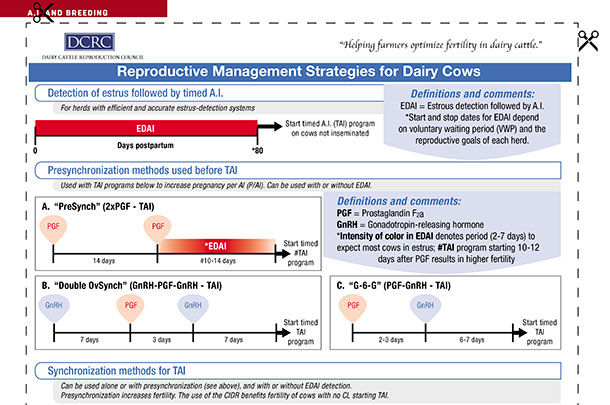The updated protocols are based on the latest peer-reviewed research published in scientific journals. Presynch strategies that combine gonadotropin release hormone (GnRH) and prostaglandin (PG) F2α increase pregnancies per A.I. by initiating ovulation in anovular cows and by increasing the proportion of cows that synchronize during an Ovsynch protocol. Including a second PGF2α treatment 24 hours after the first in a seven-day Ovsynch protocol increases luteal regression, which increases pregnancies per A.I. – particularly in multiparous cows.
At last year’s DCRC annual meeting, Paul Fricke, University of Wisconsin dairy science professor and extension specialist in dairy cattle reproduction, reviewed the evolution of timed-A.I. protocols and gave an overview of DCRC’s updated and recommended estrous synchronization protocols for dairy cows and heifers.
At first glance, it may seem that the “new” DCRC estrous synchronizations protocols offer many options. In reality, reproductive management strategies have generally consolidated into a few options, depending on the extent dairy managers want to use A.I. to a detected estrus versus timed A.I.
For a couple of decades, estrous synchronization protocols have helped enhance reproductive success on many dairy farms. And like most evolving technologies, there is not one “right way” to approach reproductive management, including “synch” programs.
“Many strategies can be implemented to achieve excellent 21-day pregnancy rates by increasing the A.I. service rate alone,” said Fricke. “Newer fertility programs increase both service rate and pregnancies per A.I. Each individual farm must implement a plan to submit cows for first A.I. and to identify nonpregnant cows and return them to A.I. service to maximize the 21-day pregnancy rate.”
Developing and optimizing fertility programs for first and resynchronization timed A.I. remains an active research area, despite its 20-year history. “It takes time for researchers to sift and winnow ideas and data to reach a consensus on protocols to recommend for use on commercial dairy farms,” said Fricke.
Rest assured, synchronization protocols and recommended reproductive management strategies will most certainly change in the future. “Scientific progress holds the potential to change long-standing recommendations,” said Fricke.
DCRC’s current synchronization protocol recommendations can be found on the Dairy Cattle Reproduction Council's webiste. Or refer to the tear-out pages in this issue of Progressive Dairy.
Click here or on the image above to view it at full size in a new window.
JoDee Sattler is the Marketing and Communications Director with the Dairy Cattle Reproduction Council.







